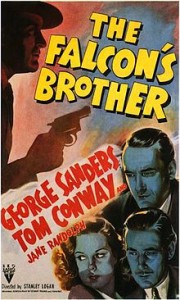The Falcon’s Brother **½ (1942, George Sanders, Tom Conway, Jane Randolph, Keye Luke, Don Barclay, Cliff Clark) – Classic Movie Review 3209
A tale of two Falcons: with so much going on, there is never a dull moment in The Falcon’s Brother.
Director Stanley Logan’s 1942 black and white B-movie thriller The Falcon’s Brother again stars George Sanders for the fourth and final time as crime writer Michael Arlen’s character Gay Lawrence, the amateur sleuth known as The Falcon. But here Sanders teams up with his real-life brother Tom Conway (who then took over as The Falcon for the rest of the series of nine subsequent films) as his movie brother Tom Lawrence in order to defeat an Axis conspiracy involving a fashion magazine, Nazi espionage and political assassination.
It is the only film to feature two Falcons. It would have been a unique opportunity to have the two brothers sleuthing together as crime-busting partners, but, though they appear briefly, and poignantly together, they sleuth in different parts of the film, and Sanders is in a coma, unconscious in his apartment for a large chunk of a short film.
Tom Lawrence is on a case when he is reported murdered on a ship arriving from South America, and Gay Lawrence pursues the reported murderers, although he knows his brother is still alive. But when Gay is injured by a speeding car driven at him, and being nursed back to health, Tom takes over the investigation.
The Falcon’s Brother co-stars Jane Randolph as eager reporter Marcia Brooks, Don Barclay as The Falcon’s assistant Lefty, Cliff Clark as Police Inspector Timothy Donovan, Edward Gargan as Detective Bates, Keye Luke as Gay’s houseboy Jerry and Charles Arnt as Pat Moffett, who are also aptly cast for screen-writers Stuart Palmer and Craig Rice’s complex original screenplay yarn.
It is a shame that complex plotting turns into convoluted plotting, with the far-fetched Hitchcock-style Nazi spies and political assassination angle over-familiar and botched, and that the film is sluggishly directed without any inspiration by Logan, and that there is some clumsy handling, ragged performances and silly comedy. The film’s remit is ambitious, too ambitious for 63 minutes, so the all-important climax is rushed.
It has to be said that Allen Jenkins as Goldie Locke and James Gleason as Police Inspector Mike O’Hara are missed, with Barclay and Clark not nearly as good in similar roles.
But, with so much going on, there is never a dull moment in The Falcon’s Brother. It is still entertaining and engrossing enough as a basic B-movie mystery crime drama, entertainment, with one or two neatly done bursts of action (as when Gay is injured by a car driven at him) and visual flourishes, such as the moment Conway appears lit up from the shadows, like Orson Welles in the later The Third Man. It is a striking introduction to the character, boding well.
And it was a hit since audiences were eager to know what happened to Sanders’s popular character and accepted Conway as his replacement. It is unfair to compare, though the film compels you to, and Conway is second best but nearly as smooth, suave and classy as Sanders, with a good vocal style and superior presence.
Also in the cast are George J Lewis as Valdez, Amanda Varela as Carmela, Eddie Dunn as Detective Grimes, Charlotte Wynters as Arlette, James Newill as Paul Harrington and Gwili Andre as Diane Medford, André Charlot as Savitski, Mary Halsey as Miss Ross, Richard Martin as Steamship official, Julie Warren as flashy girl, Ken Harlan as Torrence, Andre Marsaudon as Dr. De Sola, John Dilson as Ship’s doctor, Eddy Chandler as First mate, Jack Gargan as Steward, Tommy Tucker as Boy, Kay Aldridge as Spanish girl/ Victory gown model, Georgia Carroll as Magazine cover girl, Bonnie Kildare as Miss Honolulu, Max Waizman as Devlin, Percy Launders as Arlette’s doorman and Ralph Brooks as Arlette’s attendant.
The Falcon’s Brother was a hit, earning a profit of $128,000 and the Conway-starred films did good business.
[Spoiler alert] Sanders said he no longer wished to make films in the series in January 1942. RKO persuaded Sanders to star in one more Falcon film by the inducement of having his brother take over the lead role, which would further his career. Sanders agreed but insisted his character be killed off in The Falcon’s Brother. He sacrifices his life as a hero, but he does this for a character we haven’t got to know and don’t care about, and it doesn’t seem at all a Falcon-like thing to do.
The first Sanders Falcon entry was The Gay Falcon (1941), quickly followed by A Date with the Falcon (1942), The Falcon Takes Over (1942), based on Farewell, My Lovely, and finally The Falcon’s Brother (1942).
The only other film the two brothers appeared in together was Death of a Scoundrel (1956), again playing brothers.
Conway played the new Falcon in nine subsequent films: The Falcon Strikes Back (1943), The Falcon in Danger (1943), The Falcon and the Co-eds (1943), The Falcon Out West (1944), The Falcon in Mexico (1944), The Falcon in Hollywood (1944), The Falcon in San Francisco (1945), The Falcon’s Alibi (1946) and The Falcon’s Adventure (1946).
© Derek Winnert 2015 Classic Movie Review 3209
Check out more reviews on http://derekwinnert.com





